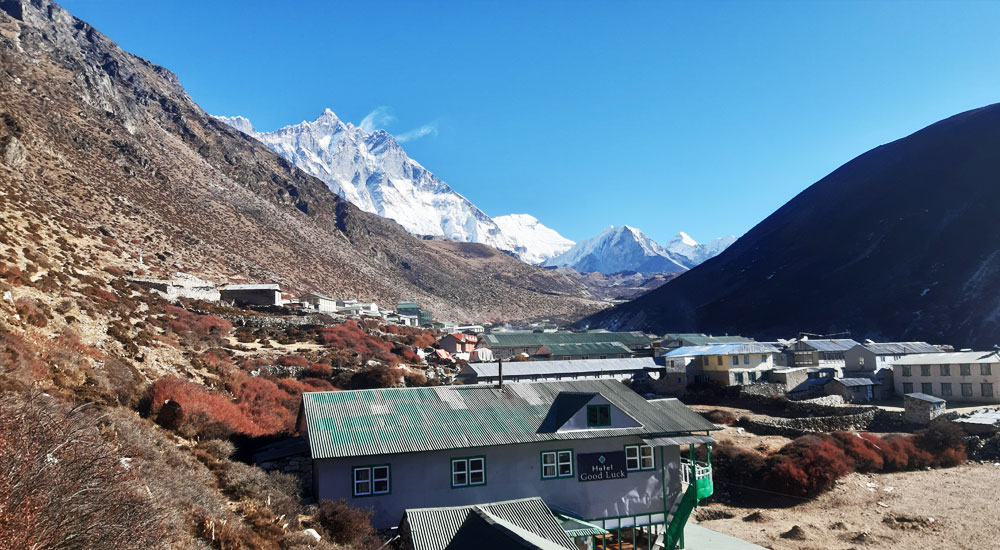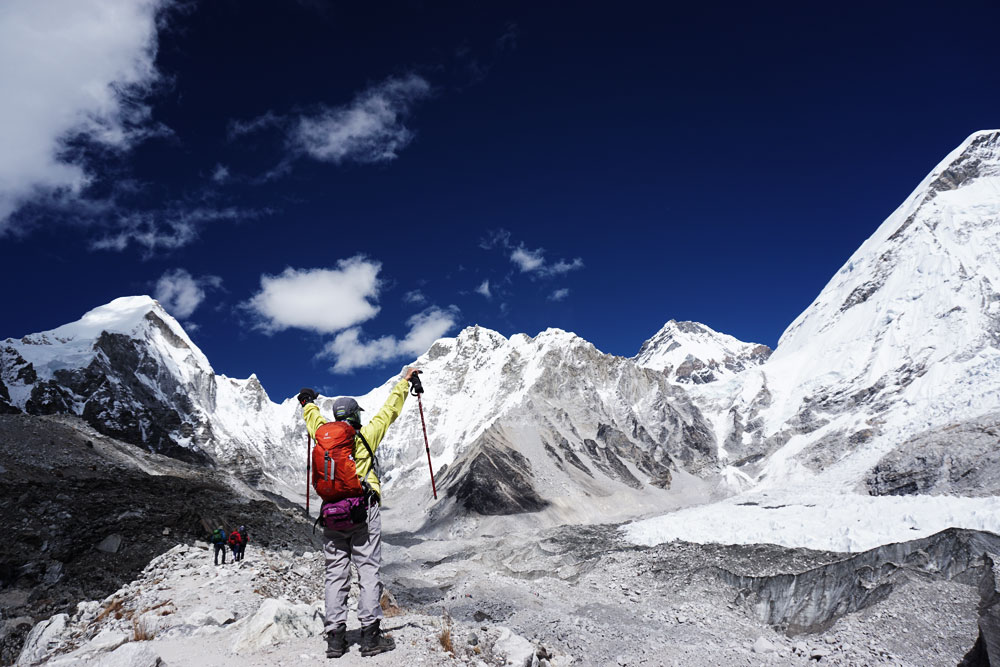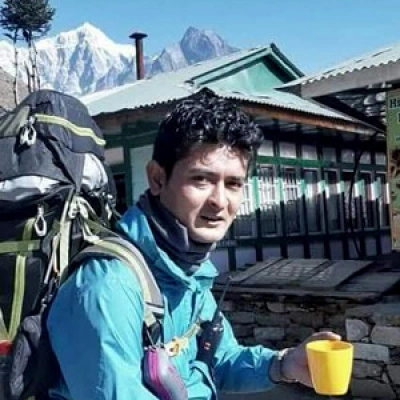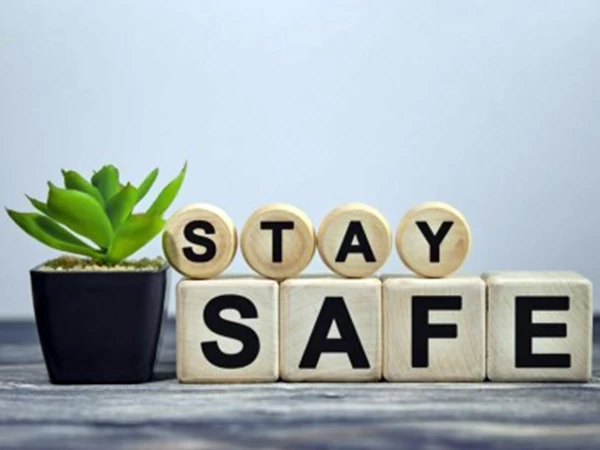Major Highlights of the Trek
- Incredible mountain vista of the entire Everest Mahalangur Himalayan range
- Up close view of some of the highest mountains in the world including Mt. Everest, Mt. Lhotse, Mt. Nuptse, Mt Ama Dablam, and others
- Exploring the surreal Everest Base Camp and surroundings
- Walking through the pristine landmarks of Sagarmatha National Park, a UNESCO world heritage site
- jaw-dropping sunrise from Kala Patthar overlooking the snow-capped mountains
- Scenic mountain helicopter ride from Kalapathar to Kathmandu
- Opportunity to explore the culture, heritage, and lifestyle of the Sherpa community
- An abundance of flora and fauna along the trail
- Heartwarming hospitality of the Nepalese people
When is the Ideal Time for Everest Base Camp Trek 8 Days?

Although the trek to Everest Base Camp is doable throughout the year, the best time to trek the region is Autumn (September-November) and Spring (March-May).
Autumn (September-November)
The autumn season brings dry and warm weather to the region after the wet monsoon season. The temperatures and weather are perfect for trekking in the day time. You can observe the incredible views of the highest mountains in the world.
Besides that, the environment is also festive, as many locals celebrate many festivals at this time of the year. Trekkers can explore the cultural aspect of the region as well.
Spring (March-May)
The Everest region is incredibly beautiful, and the natural landscape of the region comes alive in the spring season. There are wildflowers like rhododendron blooming all over the trails of the Everest Base Camp.
This magnificent scenery attracts many trekkers in the Everest Base Camp region. You can also observe the rare wildlife that becomes active after a long winter. There is heavy rainfall in the region during the monsoon and the summers.
The temperatures dip below 0 degrees Celsius in the winters. The slippery trails, risk of avalanches, and landslides makes the trails tough. The offseason treks are definitely challenging but with proper preparation it is possible.
Articles you may like to read:
How Difficult is the 8 Days Everest Base Camp Trek?
The Everest Base Camp trek is quite challenging. The trails pass through the foothills of the Himalayas and generally stay above 4000m at all times. The trek is incredibly challenging for first-time trekkers who have not trekked such high altitudes before.
Even the most veteran of trekkers fall prey to the Altitude sickness in the region. The low levels of oxygen and the freezing temperature makes it highly challenging to breathe. With proper acclimatization and hydration, altitude sickness can get prevented.
For those who cannot escape altitude sickness, descending to lower altitudes will help them recover faster. The pro tip is to walk gently with a steady pace. Trekkers will have to walk 5-8 hours on average, depending upon their pace.
The challenging trails move up and down rapidly. Thus, a basic level of fitness is a must for the 8 days Everest Base Camp Trek. To gain fitness for the trek, a training routine at least two weeks before the trek is a must. These factors make an impact on the difficulty level of the trek.
Food and Accommodation along the Trek
Treks around the Everest region are also known as teahouse treks. In the 8 days Everest Base Camp trek, you will be relying upon local tea houses for food and accommodation. The rooms are available on a twin sharing basis. The tea houses also provide a pillow, furniture, and a warm blanket.
You can get hot water facilities at an added cost at some teahouses. The tea houses provide three sit in meals as well. For breakfast, you get porridge, bread toast, and eggs, along with hot drinks like tea and coffee. You can also gorge on freshly baked bakery items in Lukla, Namche, and Tengboche.
The staple dish of “Dal Bhat” is popular for lunch and dinner. Dal Bhat consists of rice, dal, lentils, spinach, meat, vegetables, and pickles. There are a limited variety of western and Chinese dishes including pizza, momo, chow mein, burgers, pasta, and others as well.
The remoteness of the trails makes it difficult to carry food ingredients in the high mountains. Thus, you will find less variety of dishes as you move higher along the trek.
Everest Base Camp Trek 8 Days - Important Tips
- Acclimatization is the key to trek the Everest region successfully
- Hiring a guide and a porter is advisable
- Hydrate regularly during the trek
- Pack only those items and equipment that are necessary
- Set a basic training regime at least two weeks before the trek
- Increase your diets and carbohydrates and protein intakeStart your trek as soon as possible
- For connectivity, get a local SIM card with a data connection
- Get yourself an ideal Travel insurance package
Everest Base Camp Trek 8 Days - Packing List
The Everest Base Camp trek of 8 days requires a heavy packing. Some of the essential items you need to pack are as follows:
Clothing
- Short-sleeved Trekking shirts
- Long-sleeved Trekking shirts
- Trekking boots
- Trekking pants and jackets
- Thermals underwear
- Woolen cap
- Insulating down jackets
- Trekking Gloves
- Raincoats
First Aid
- Diamox tablets
- Band-aids
- Anti-nausea Medicines
- Mosquito and insect repellents
Toiletries
- Toilet Paper
- Soap
- Moisturizer
- Sunscreen
- Shampoo
- Hand sanitizer
Accessories
- Sleeping bag
- Sunglasses
- Cameras
- Solar Chargers
- Water Bottle
- Hot water Thermos
Important Documents
Detailed Itinerary of 8 Days Everest Base Camp Trek
.jpg)
Day 01: Fly to Lukla and trek to Phakding
Maximum altitude: 2860 m
Flight duration: 35 minutes
Trek duration: 3-4 hours
We fly early on a scenic mountain flight to Lukla from Kathmandu. The scenic mountain flight lands at the Tenzing - Hillary Airport in Lukla. We trek to Phakding after a brief rest at Lukla.
The short trek passes along the side of the Dudh Kosi river and Ghat village. We arrive at Phakding after a trek of around 3-4 hours and stay overnight.
Day 02: Trek to Namche Bazaar
Maximum altitude: 3441 m
Trek duration: 6 hours
After breakfast, we start our trek from Phakding to Namche Bazaar. There are several suspension bridges and a beautiful waterfall along the trail. We can view the majestic Mt. Thamserku on the trail. We finally arrive at Monjo after a short trek.
You have to display your entry permits at a checkpoint in Monjo. The Sagarmatha National Park is a world heritage site that works in the conservation of wildlife in the region. We continue our trek to the pristine Khumbu valley to reach Jorsale.
We have our lunch at Jorsale and then resume our trek crossing several suspension bridges over the Dudh Koshi river. Finally, after a trek of almost 6 hours, we arrive at the famous Namche Bazaar. Namche bazaar is a bustling town in the Khumbu region with many restaurants, cafes, pubs, and even a bakery. We overnight at a lodge in Namche.
Day 03: Acclimatization day at Namche Bazaar
Acclimatization is an essential process in the high altitude region. We acclimatize at Namche and explore the neighborhood. You can hike to the famous Khunde and Syangboche airstrip.
You can also visit the Sherpa Museum dedicated to the achievements of the Sherpa community. There are also many places to relax in Namche. You can stay overnight at a lodge in Namche.
Day 04: Trek to Tengboche
Maximum altitude: 3860 m
Trek duration: 5 hours
After breakfast, we start our trek on an easy path. We trek further to arrive at Kyanjuma. The spectacular viewpoint in Kyanjuma provides us with the panoramic vista of the entire Himalayan mountain range.
The trails then pass through the forest area with hundreds of rhododendron and pine trees. We descend further for 45 minutes to arrive at the Phunki Tenga river. We finally arrive at Tengboche after a trek of few hours.
The beautiful Tengboche is a spiritual place in the Himalayas on the lap of the Ama Dablam. You can pay a visit to the holy Tengboche monastery and pray for the successful completion of the trek. We rest in the evening and stay overnight at a lodge in Tengboche.
Day 05: Trek to Dingboche
Maximum altitude: 4350 m
Trek duration: 5 hours
We start our trek early after breakfast and pass through the alpine forests of rhododendron trees. We then cross a wooden bridge to arrive at the village of Pangboche after 30 minutes.
We have our lunch at Pangboche. The trail from Pangboche is wide and extended. We reach Dingboche, after a trek of another 3 hours and stay overnight at a lodge.
Day 06: Trek to Lobuche
Maximum altitude: 4910 m
Trek duration: 5 hours
After breakfast, we start our trek to Lobuche. The steep ascent will drain you, but the enchanting views of the Everest, Amadablam, Makalu, and others will liven up your spirits. We arrive at Thukla after a trek of almost 2-2.5 hours.
We climb up a steep ridge to the Memorial Chorten, dedicated to the mountaineers who lost their lives in the mountains. The challenging Lobuche Pass lies ahead of us, and after crossing the pass, we observe the pristine Khumbu glacier in all its glory. We arrive at Lobuche after a trek of 2 hours, and we spend the night at a lodge.
Day 07: Trek to Everest Base Camp and return to Gorak Shep
Trek duration: 8 hours
Maximum altitude: 5365 m
Walking distance: 15 km
After breakfast, we start our trek to Gorak Shep. Gorak Shep is a stunning frozen lake bed and also the original Everest Base Camp. There you can find an Italian research center. After observing the beauty of the astonishing place, we resume our trek through the moraine route towards the Everest Base Camp.
The atmosphere of Everest Base Camp is bustling and full of energy. The close-up views of the mountains will amaze you. We explore around the area and take pictures and then descend back to Gorak Shep. We will stay the night at a Lodge in Gorak Shep.
Day 08: Hike to Kalapathar early in the morning and helicopter flight back to Kathmandu
Maximum altitude: 5555 m
Trek duration: 8 hours
The hike to Kalapathar starts early in the morning. We observe the awe-inspiring sunrise from Kalapatthar. The golden rays of the sun turning the silver mountains golden is a once in a lifetime experience.
The most beautiful pictures of Mt Everest get clicked from Kala Patthar. We then proceed to have a delicious breakfast overlooking the greatest views of the mountains. We then resume our trip from Kala Patthar on a helicopter.
You can observe the magnificent aerial views of the mountains from the top. The scenic mountain helicopter ride is the highlight of the trek. After arriving at Kathmandu, we celebrate the success of the trek at the hotel.

Everest Base Camp Trek 8 Days - Frequently Asked Questions (FAQs)
Where is Everest Base Camp?
Everest Base Camp lies in the Everest region, of Solukhumbu district in Nepal.
What is the elevation of Everest Base Camp?
The elevation of Everest Base Camp is 5,380m from the southern side in Nepal.
Food and accommodation along the Everest Base Camp?
The local tea houses and lodges provide accommodations on twin sharing basis because of less space. You will get a basic bed, pillow, and a warm blanket in the room. The local Dal Bhat is famous on the trails with some western cuisines as well. However, there is a limited variety on the menu because of the remoteness of the trek.
What are Clothes and equipments needed along the trek?
Trekking clothes and gears are essential for the success of the trek. You need to pack all the essential stuff, including trekking shoes, boots, poles, socks, gloves, hats, and others. You can check the separate section dedicated to clothing and gear in this article.
When is the best time to trek to Everest Base Camp?
The best time to trek to Everest in the autumn (September to November) and spring (March to May) season. The weather is stable, and the temperatures are moderate at this time of the year.
Can I trek in the offseasons?
The monsoon season brings heavy rainfall in the region. The trail gets slippery with further risks of avalanches and landslides. The cloudy sky also covers the spectacular Himalayas. Similarly, the freezing weather conditions in the winter is also not favorable. However, with proper preparation and gear, the trek to Everest Base Camp is doable.
What to do in case of altitude sickness during the trek?
To avoid altitude sickness, you have to drink lots of water and acclimatize regularly during the trek. You can also carry an effective medicine called Diamox and have it as soon as you get the attack.
The professional guides are well equipped to help you in any emergency. You can descend 300m if the conditions become severe or evacuated if necessary.
Can beginners trek the Everest Base Camp?
Yes, beginners can trek Mount Everest Base Camp too. While trekking in the region is strenuous, but with proper preparation, you can complete this trek. A basic training regime before the trek, including cardiovascular activities like swimming, hiking, aerobics, etc. is ideal. This training regime increases your fitness and stamina.
How much cash do i need to carry on the Everest Base Camp Trek?
On an average, 25$ to 30$ per day is ideal for the Everest Base Camp trek. This includes accommodations, food, and others.
Should I hire a guide or a porter or both?
Hiring a guide is a good option for the Everest Base Camp trek. You can also hire a porter if you find it difficult to trek and walk. Some guides also work as a porter.
What is the procedure in case of any emergency?
The rescue team is well equipped in case of any emergency. The local guides are well-skilled in first aid facilities, as well. There is also a provision of Helicopter evacuation.
Related Trips:
Contact Us for more detail information on packages.



.jpg)



